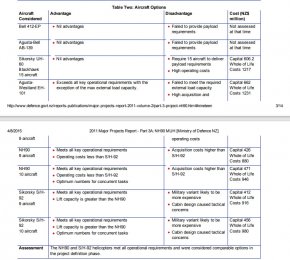@Raven22 and @Takao The following is from the 2011 NZ Ministry of Defence Projects Report, pp 3/14 - 15.

So from that you can see my math was definitely off. You would be looking at 70 Blackhawks to replace 47 MRH. Although I wonder now if the Sikorski S-92 may have been the better deal. Not the NZ capital cost for 9 NH90 was NZ$771 and of those 9 only 8 are flyable, the 9th being the spare parts bod. By the way these figures are for full aircraft availability, so @old faithful you would definitely need 70 Blackhawks for the same amount of lift of the 47 MRH are required to provide, not what you you are getting at the moment.

So from that you can see my math was definitely off. You would be looking at 70 Blackhawks to replace 47 MRH. Although I wonder now if the Sikorski S-92 may have been the better deal. Not the NZ capital cost for 9 NH90 was NZ$771 and of those 9 only 8 are flyable, the 9th being the spare parts bod. By the way these figures are for full aircraft availability, so @old faithful you would definitely need 70 Blackhawks for the same amount of lift of the 47 MRH are required to provide, not what you you are getting at the moment.
